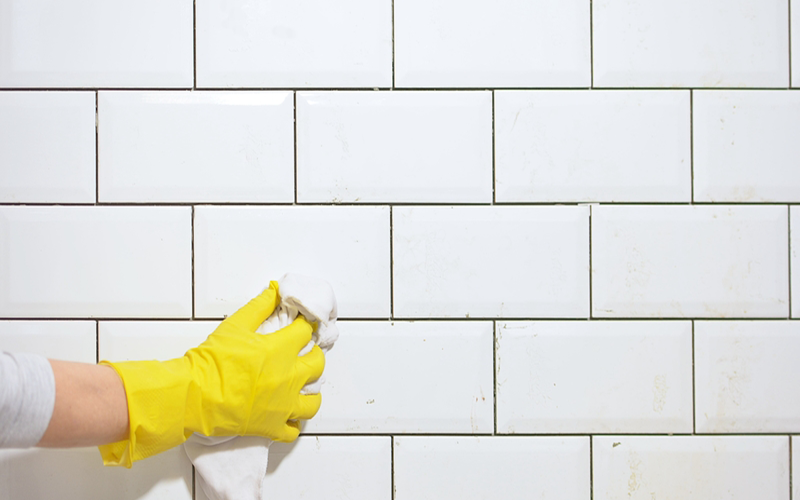Welcome to Naveen Ceramic & Vitrified Tiles...

Naveen Complex,
7th and 8th Floor,14, M.G.Road, Bangalore – 560001

Send your mail at

Have any question?
How to Clean and Maintain your Kitchen Tiles

The kitchen is the heart of your home. It is one of the rooms in the house that sees the most activity; cooking, eating, and even just relaxing and killing time all take place there. With continuous traffic, your kitchen floor is subjected to spills, mud, and grit tracked in from outdoors, as well as various stains and scrapes that wear down your kitchen floor. Despite their durability, kitchen tiles will eventually seem permanently dirty and damaged if they are not properly maintained. However, with the proper maintenance and methods, you can keep them looking new and vibrant for years. So if you are in a dilemma on how to clean your kitchen tiles, here are some simple tips.
Things to consider before buying tiles
The finest tiles for a kitchen floor would be porcelain or natural stone, depending on how you use your kitchen space. Both choices are robust and long-lasting so that they can sustain significant wear and tear over time. It’s important to note that various tile kinds may require various cleaning techniques and tools. For instance, because ceramic and porcelain tiles are frequently pre-sealed and durable, they can be cleaned using abrasive materials like rags or brushes and more concentrated cleaning solutions. On the other hand, natural stone tiles’ extremely porous, stain-prone nature necessitates a gentler approach involving using a natural cleaning chemical together with less abrasive cloths or brushes.
Common Cleaning Tips
Daily sweeping and vacuuming will keep your kitchen clean and make deep cleaning easier. Don’t forget to sweep before you mop as well. It becomes difficult to remove grime when loose dirt is absorbed in water. Spills should be cleaned up as quickly as possible to prevent stains. As soon as a spill occurs in your kitchen, take quick action to clean it up. The whole artillery of bacteria can be found in the kitchen, so stock up on disinfectant. Keep a disinfectant on hand to prevent injury to your skin or even your pets. Use two mops: two mops allow for quicker and more thorough cleaning.
Cleaning the Kitchen Wall Tiles
The same care and regular cleaning are required for wall tiles. Create a cleanup plan while keeping the types of tiles you have in mind. Do you have plain ceramic tiles? Use the standard scouring pad. Use a soft sponge or microfiber cloth on patterned or printed tiles.
Using an efficient tile cleaner, warm water, and a soft cloth, you may make the tiles grease and stain-free by scrubbing the filth away. Use warm water, and if necessary, a fresh, clean cloth. When you’re done, dry the kitchen tiles with a new towel to bring out their shine.
Sweep and vacuum the kitchen tiles.
You should not only sweep and vacuum your kitchen tiles every day, but you must also do so before you use any water on them. The cleaning process will be less painful if loose dirt is removed with a broom and a vacuum. Even if you use a dustpan to clean the area, you should vacuum afterwards just to be safe. An excellent vacuuming tip is to vacuum between the grout lines since sometimes a broom can’t get loose dirt trapped there.
Start with the difficult stains.
Removing any stains that are particularly difficult to remove from your kitchen tiles is recommended. You’ll save time by tackling the problematic stains first. Additionally, cleaning will go much more smoothly for you. Use scouring powder and warm water to clean up spills and stains. You can make your scouring powder at home using natural components or purchase one of the many branded powders available on the market; both work very well.
Rub the tough spot with your 50/50 solution (half warm water, half scouring powder), then let it sit for 10 minutes. Wash the area with a clean towel and warm water after ten minutes, then scrub it with a soft brush until it’s clean.
Obtain the grout.
It might seem odd to grout before mopping. If necessary, we should only clean the grout once a month or so because it is a difficult task. When you finally get around to grouting, mop first. The same as for addressing the stains first. This is done to save time and be more efficient. You’ll note that frequently rinsing off the grouting solution takes a long time. However, you’ll save time and thoroughly remove dirt if you grout your kitchen tiles before mopping. The best grout cleaning solution is natural; baking soda is the most effective substance. Thoroughly scrape the grout with an old toothbrush and a mixture you’ve made from baking soda and water. Rinse out the paste with a spray bottle of water. You’re about to mop, so don’t spend too much time on this. Continue until the grout is spotless. If the grout is tough to remove, consider letting the paste soak for a while. After that, use the toothbrush to scrub it.
Time to Mop.
The grout is cleaner than ever, and the tenacious spots have disappeared. It’s time to mop now. While all-purpose cleaners are fantastic, you’ll first need to prepare a solution, and nothing gets rid of deep-seated grime better than warm water and vinegar. Combine a half cup with little water and dish detergent to clean your kitchen tiles. To prevent soap residue from attracting dirt to your tiles, thoroughly rinse the floor. Take a second mop to dry the floor, then enjoy your sparkling new kitchen tiles.
For a deep clean, follow the procedures highlighted above. But you should incorporate some of the advice into your regular cleaning schedule.
Apart from these easy tips, follow a daily and monthly clean-up ritual for your kitchen; it will never disappoint you! For more information on cleaning and tiles, visit our website www.naveentile.com
